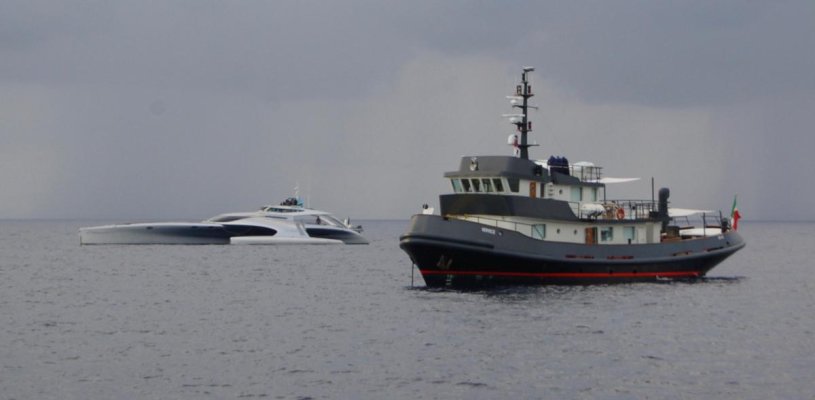You are using an out of date browser. It may not display this or other websites correctly.
You should upgrade or use an alternative browser.
You should upgrade or use an alternative browser.
New Long Thin, Hyper-Efficient Trawler
- Thread starter LRC58Fan
- Start date
The friendliest place on the web for anyone who enjoys boating.
If you have answers, please help by responding to the unanswered posts.
If you have answers, please help by responding to the unanswered posts.
FF
Guru
- Joined
- Oct 12, 2007
- Messages
- 22,552
"Re TAD's "efficient motor yacht" she looks like a sailboat to be sure. Reminds me of the days where I was thinking of making a trawler out of a sailboat hull."
Works great makes a fine efficient cruiser , TILL its sales time and most folks are dockside most of the time and prefer a Roomaran.
Remember the very fine one for sale on this site.Winny the Poo.
Took almost 2 years to find a understanding purchaser, that wanted efficiency not just volume.
Works great makes a fine efficient cruiser , TILL its sales time and most folks are dockside most of the time and prefer a Roomaran.
Remember the very fine one for sale on this site.Winny the Poo.
Took almost 2 years to find a understanding purchaser, that wanted efficiency not just volume.
"
Remember the very fine one for sale on this site.Winny the Poo.
Took almost 2 years to find a understanding purchaser, that wanted efficiency not just volume.
Tell me more about this "Winny the Poo" boat - I didn't see it. Where was it listed?
Diesel Duck
Senior Member
Tell me more about this "Winny the Poo" boat - I didn't see it. Where was it listed?
http://trawlerpooh.blogspot.com
Last edited by a moderator:
eyschulman
Guru
- Joined
- Apr 1, 2014
- Messages
- 1,288
The W-P is a boat with the essentials of good cruising without the cottaged-up stuff. It is a boat and not what most new age trawler buyers are looking for. The trend is I want something like my land house that can travel on the water.
Nomad Willy
Guru
eyschulman,
It's more like "The whole ball of kelp" or was it wax .. than a trend.
W-P was twice the weight of my Willard, twice the money and twice the power. Same 5hp per ton power loading.
It's more like "The whole ball of kelp" or was it wax .. than a trend.
W-P was twice the weight of my Willard, twice the money and twice the power. Same 5hp per ton power loading.
Last edited:
I recently sent an email to Dickey Boats , the LRC 56 has my eye..
Just an update, I sent a couple of emails to Dickey Boats , wanted more info on the LRC 58, no response, I used the contact from there website..
Tony B
Guru
- Joined
- Jul 18, 2011
- Messages
- 1,251
- Location
- Cruising/Live-Aboard USA
- Vessel Name
- Serenity
- Vessel Make
- Mainship 36 Dual Cabin -1986
Definitely looks like a sailboat hull from yesteryear. The long narrow design is more sea kindly than a wider boat. The newer sailboats are much fatter at the rear end, much like their owners. When the sailboat industry realized that most sailors are not going to cross oceans, they widened the boats for more interior space.
So, what it appears that Tad did is to design a long narrow full displacement sailboat hull.
This gives great hull efficiency and the cost of interior space. My last sailboat was 39' long and my present power boat is a Mainship 36 which is 36'long. The Mainship has about 4 times the interior space and about 4 to 6 times the usable back deck space.
The sailboat, when under power would get about 10 mpg at 7 kts and the power boat gets about 1 3/4 MPG at the same 7 kts.
Anyway, Tad - nice looking boat. Congrats.
So, what it appears that Tad did is to design a long narrow full displacement sailboat hull.
This gives great hull efficiency and the cost of interior space. My last sailboat was 39' long and my present power boat is a Mainship 36 which is 36'long. The Mainship has about 4 times the interior space and about 4 to 6 times the usable back deck space.
The sailboat, when under power would get about 10 mpg at 7 kts and the power boat gets about 1 3/4 MPG at the same 7 kts.
Anyway, Tad - nice looking boat. Congrats.
hollywood8118
Guru
- Joined
- Nov 16, 2009
- Messages
- 2,379
- Location
- USA
- Vessel Name
- " OTTER "
- Vessel Make
- Ocean Alexander Europa 40
Definitely looks like a sailboat hull from yesteryear. The long narrow design is more sea kindly than a wider boat. The newer sailboats are much fatter at the rear end, much like their owners. When the sailboat industry realized that most sailors are not going to cross oceans, they widened the boats for more interior space.
So, what it appears that Tad did is to design a long narrow full displacement sailboat hull.
This gives great hull efficiency and the cost of interior space. My last sailboat was 39' long and my present power boat is a Mainship 36 which is 36'long. The Mainship has about 4 times the interior space and about 4 to 6 times the usable back deck space.
The sailboat, when under power would get about 10 mpg at 7 kts and the power boat gets about 1 3/4 MPG at the same 7 kts.
Anyway, Tad - nice looking boat. Congrats.
the flat wide stern on a sailboat has a LOT more to do with making the boat fast/efficient/steerable off the wind than just for room.. look no further than all the fast ( planing) racing sailboats that the stern is practically the widest part of the boat.. they don't build race boats fat just to be "roomy".
beam adds stability.
HOLLYWOOD
hollywood8118
Guru
- Joined
- Nov 16, 2009
- Messages
- 2,379
- Location
- USA
- Vessel Name
- " OTTER "
- Vessel Make
- Ocean Alexander Europa 40
"Re TAD's "efficient motor yacht" she looks like a sailboat to be sure. Reminds me of the days where I was thinking of making a trawler out of a sailboat hull."
Works great makes a fine efficient cruiser , TILL its sales time and most folks are dockside most of the time and prefer a Roomaran.
Remember the very fine one for sale on this site.Winny the Poo.
Took almost 2 years to find a understanding purchaser, that wanted efficiency not just volume.
efficiency aside,
the reason "Poo" took so long to sell was is was a cobbled together/homemade looking boat. Most don't want a boat that look like is was assembled in someones back yard.
HOLLYWOOD
Tony B
Guru
- Joined
- Jul 18, 2011
- Messages
- 1,251
- Location
- Cruising/Live-Aboard USA
- Vessel Name
- Serenity
- Vessel Make
- Mainship 36 Dual Cabin -1986
the flat wide stern on a sailboat has a LOT more to do with making the boat fast/efficient/steerable off the wind than just for room.. look no further than all the fast ( planing) racing sailboats that the stern is practically the widest part of the boat.. they don't build race boats fat just to be "roomy".
beam adds stability.
HOLLYWOOD
That might be true of small race boats that plane. The big ones do not plane and no displacement hull ever will. The wide bodied sailboats like Hunters and Catalinas are a nightmare in rough seas. The slam and pound rather than slice through the water.
Anyway, if you look at the stern of most mid-size and larger sailboats with true displacement hulls, look down near the waterline. the hull comes to a point. The underwater part of a ocean crossing or rough water sailboat has a canoe shape both fore and aft. Also a narrow beam with a heavy keel takes up less lateral space in the water than a wide beam and so, given the shape of a wave. the narrow beam will be stand more vertical - less surface contact is less likely to follow the contour of the wave.
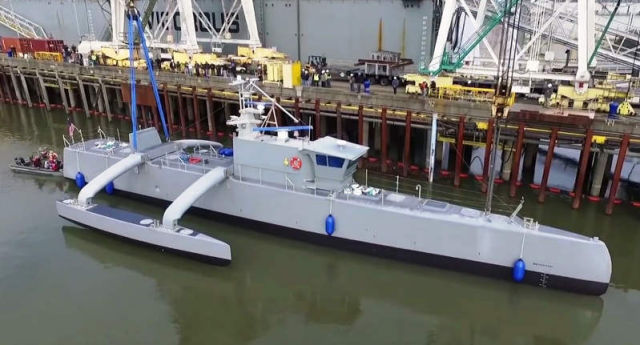
An interesting update on a "long thin" autonomous design (drone ship) by the defense department. I find this type of effort very interesting - perhaps some other people here will also. It certainly suggests that its not too much to expect a couple of people to navigate a boat that is 40 meters (132 feet) long on long distance voyages.
"DARPA’s Anti-Submarine Warfare (ASW) Continuous Trail Unmanned Vessel (ACTUV) program has designed, developed and constructed an entirely new class of ocean-going vessel—one intended to traverse thousands of kilometers over the open seas for months at a time, all without a single crew member aboard."
Video of testing Below:
another video here:
=====
The U.S. Navy's newest sub-hunting maritime drone successfully completed preliminary speed and maneuverability testing in preparation for its christening into the fleet this month.
A technology demonstration version of the Anti-Submarine Warfare (ASW) Continuous Trail Unmanned Vessel, or ACTUV, completed the open water drills near Portland, Ore., according to a Defense Department fact sheet.
====
FULL details on boat here:
ASW Continuous Trail Unmanned Vessel - Wikipedia
Last edited:
Just read more about this long thin DARPA ship... some people have made the comment that they have never seen multi-hulls like this in really rough water. Obviously this is an issue if the ship suffers from a roll-over as they don't recover like mono-hulls, but it seems that the US defense department is satisfied with the design, perhaps it works for the more casual boater. Here is a recent quote:
of course, we'll see how testing goes over the next two years. here is the source document:
Submarines: Yet Another Robotic Sub Hunter
ACTUV is designed to operate in up to Sea State 5 (six meter waves and 38 kilometer and hour winds and survive Sea State 7 (nine meter waves and 59 kilometers an hour winds). Since ACTUV will always have humans monitoring it and able to take control the vessel can be move out of the way of major storms (that go up to Sea State 12). The first ACTUV (called Sea Hunter) is now starting two years of sea trials.
of course, we'll see how testing goes over the next two years. here is the source document:
Submarines: Yet Another Robotic Sub Hunter
So Mr. LRC58Fan, are you moving forward with your plans or creating a detailed budget for your vessel?
I received a quote to build a 70' long skinny boat for about the same cost as a 50' wide fat one. Same displacement. I am not going to be a full time live aboard, so when I start budgeting for marina fees in various ports the numbers are a true deal-killer!
I received a quote to build a 70' long skinny boat for about the same cost as a 50' wide fat one. Same displacement. I am not going to be a full time live aboard, so when I start budgeting for marina fees in various ports the numbers are a true deal-killer!
MurrayM
Guru
I received a quote to build a 70' long skinny boat for about the same cost as a 50' wide fat one. Same displacement. I am not going to be a full time live aboard, so when I start budgeting for marina fees in various ports the numbers are a true deal-killer!
Even after factoring in the smaller engine(s) and reduced fuel costs?
Hi,
Not moving forward yet - its going to be a few years before I pull the trigger. Still just watching and learning.
Interestingly - I've just learned of a new longer thinner ocean crossing design that is coming out of a new effort by Nigel Irens - the famous designer of many of the longer thin cruisers.
Here is more detail:

In collaboration with renowned designer and Naval Architect Nigel Irens of the U.K., Black Swan Yachts is developing a new line of offshore motor yachts that promise to change the way the adventurous at heart perceive of the possibilities.
The 22m (72ft) initial offering will blend the finest characteristics of today’s efficient low displacement to length sea-going vessels while providing unmatched interior and exterior livability. Black Swan imparts each model with the highest degree of safety, robustness, and simplicity, delivered in a modern-minimalist aesthetically pleasing package.
In keeping with our commitment to Uncompromising Offshore Passage Makers, the Black Swan line aspires to inspire a new generation of adventurers and dreamers – looking to cast off the daily grind in complete confidence – in the pursuit of attaining clearer appreciation and understanding of what a life unleashed has to offer.
Website here:
Black Swan Series - Black Swan Yachts
Not moving forward yet - its going to be a few years before I pull the trigger. Still just watching and learning.
Interestingly - I've just learned of a new longer thinner ocean crossing design that is coming out of a new effort by Nigel Irens - the famous designer of many of the longer thin cruisers.
Here is more detail:

In collaboration with renowned designer and Naval Architect Nigel Irens of the U.K., Black Swan Yachts is developing a new line of offshore motor yachts that promise to change the way the adventurous at heart perceive of the possibilities.
The 22m (72ft) initial offering will blend the finest characteristics of today’s efficient low displacement to length sea-going vessels while providing unmatched interior and exterior livability. Black Swan imparts each model with the highest degree of safety, robustness, and simplicity, delivered in a modern-minimalist aesthetically pleasing package.
In keeping with our commitment to Uncompromising Offshore Passage Makers, the Black Swan line aspires to inspire a new generation of adventurers and dreamers – looking to cast off the daily grind in complete confidence – in the pursuit of attaining clearer appreciation and understanding of what a life unleashed has to offer.
Website here:
Black Swan Series - Black Swan Yachts
So Mr. LRC58Fan, are you moving forward with your plans or creating a detailed budget for your vessel?
I received a quote to build a 70' long skinny boat for about the same cost as a 50' wide fat one. Same displacement. I am not going to be a full time live aboard, so when I start budgeting for marina fees in various ports the numbers are a true deal-killer!
Dashew has launched his new 78 ft long thin passagemaker and I like the looks - much better than the first generation.
Still - with a price of something around $7 million, its out of my price range.

more details here:
SetSail » Blog Archive » FPB 78-1 Cochise: Launched In A Gale – And In Its Element
Still - with a price of something around $7 million, its out of my price range.

more details here:
SetSail » Blog Archive » FPB 78-1 Cochise: Launched In A Gale – And In Its Element
Full details on the new BlackSwan passagemaker: What do you like or dislike?
Black Swan Announces 72-Foot, Long-Range Cruiser


Black Swan Yachts has announced the design for a contemporary, long-range passage maker, capable of cruising 5,000 miles at 9 knots (3,500 miles at 10 knots, with a max speed projected to exceed 13).
The Black Swan 72 sports a relatively narrow beam, an all-aluminum structural build containing three watertight bulkheads, and a double-hull bottom formed by integral tanks.
She will also feature 2.5kW of standard solar power in 8 panels, and a premium, semi-custom yacht fit-out on the interior.
Based on a shared philosophy with Steve Dashew’s iconic FPB trawlers, Black Swan’s new design is a collaboration between another low displacement-to-length ratio naval architect, Nigel Irens, as well as long-time FPB vets, Todd Rickard and Mark Fritzer. (“Path of Least Resistance,” July/August 2015)
Black Swan will differentiate herself from FPB in a few ways.
First, the design adds significantly to its freeboard, allowing for increased interior volume and a hydraulic garage capable of stowing a 13-foot tender.
LOA: 72’ 2”
LWL: 72’ 2”
BEAM: 17’ 5”
DRAFT: 3’ 2”
POWER: 150 hp Yanmar Diesel (x2)
CRUISE: 9 knots
RANGE: 5,000 nm
FUEL: 2,509 gallons
WATER: 1,057 gallons
Black Swan Announces 72-Foot, Long-Range Cruiser


Black Swan Yachts has announced the design for a contemporary, long-range passage maker, capable of cruising 5,000 miles at 9 knots (3,500 miles at 10 knots, with a max speed projected to exceed 13).
The Black Swan 72 sports a relatively narrow beam, an all-aluminum structural build containing three watertight bulkheads, and a double-hull bottom formed by integral tanks.
She will also feature 2.5kW of standard solar power in 8 panels, and a premium, semi-custom yacht fit-out on the interior.
Based on a shared philosophy with Steve Dashew’s iconic FPB trawlers, Black Swan’s new design is a collaboration between another low displacement-to-length ratio naval architect, Nigel Irens, as well as long-time FPB vets, Todd Rickard and Mark Fritzer. (“Path of Least Resistance,” July/August 2015)
Black Swan will differentiate herself from FPB in a few ways.
First, the design adds significantly to its freeboard, allowing for increased interior volume and a hydraulic garage capable of stowing a 13-foot tender.
LOA: 72’ 2”
LWL: 72’ 2”
BEAM: 17’ 5”
DRAFT: 3’ 2”
POWER: 150 hp Yanmar Diesel (x2)
CRUISE: 9 knots
RANGE: 5,000 nm
FUEL: 2,509 gallons
WATER: 1,057 gallons
BruceK
Moderator Emeritus
- Joined
- Oct 31, 2011
- Messages
- 13,347
- Vessel Name
- Sojourn
- Vessel Make
- Integrity 386
Are there any less expensive alternatives?Dashew has launched his new 78 ft long thin passagemaker and I like the looks - much better than the first generation.
Still - with a price of something around $7 million, its out of my price range.
more details here:
SetSail » Blog Archive » FPB 78-1 Cochise: Launched In A Gale – And In Its Element
Yes - there is at least one lower cost option - but only 2 or perhaps 3 have been built so far, so its still early. Cost is in the $600K to $700K range for the 58 footer, and I've heard they are doing some larger versions also in the 70ft range - not sure of the cost.
Artnautica LRC 58 built by Dickey Boats in New Zealand
Dickey Boats Art Nautica LRC 58 built in New Zealand | Dickey Boats
I like it, but while the designer is an experienced designer, the boat builder has never built a long distance cruiser and there is not much test data on the boat in terms of successful long distance cruises across oceans. So I'm withholding judgement for now.

Artnautica LRC 58 built by Dickey Boats in New Zealand
Dickey Boats Art Nautica LRC 58 built in New Zealand | Dickey Boats
I like it, but while the designer is an experienced designer, the boat builder has never built a long distance cruiser and there is not much test data on the boat in terms of successful long distance cruises across oceans. So I'm withholding judgement for now.

Just saw this update on Facebook:
"Dennis Harjamaa, still inspired by classic designs ranging from George Buehler’s “Troller Yacht” concept to Nigel Irens and Michael Kasten, even Philip Stark’s futuristic designs, has several designs on the drawing board, including a 20.8m and a 24m cruiser that will have 2 cabins, 2 heads, 2 engines (1 main and 1 get-home.) Currently designed for Mr. Park —whose requirements now include a crew member— we expect to see this yacht in production very soon."
Read the full story and info here:
DOMINO 20: BROADSWORD - The Ultimate Passagemaker

"He is now running Artnautica Yacht Design in Auckland, New Zealand. Four years ago, he started designing the LRC58 for himself, perhaps to prove the point that “LESS IS MORE.” With hull # 1, KOTI (“Home” in Finnish) on the launching block, Harjamaa had triggered enough of Mr. Park’s interest to start building hull #2, BROADSWORD (launched last September 2015.) Hull #3 is currently under construction at Dickey Boats. Another hull will be starting construction in Holland within a few weeks."
"Dennis Harjamaa, still inspired by classic designs ranging from George Buehler’s “Troller Yacht” concept to Nigel Irens and Michael Kasten, even Philip Stark’s futuristic designs, has several designs on the drawing board, including a 20.8m and a 24m cruiser that will have 2 cabins, 2 heads, 2 engines (1 main and 1 get-home.) Currently designed for Mr. Park —whose requirements now include a crew member— we expect to see this yacht in production very soon."
Read the full story and info here:
DOMINO 20: BROADSWORD - The Ultimate Passagemaker

"He is now running Artnautica Yacht Design in Auckland, New Zealand. Four years ago, he started designing the LRC58 for himself, perhaps to prove the point that “LESS IS MORE.” With hull # 1, KOTI (“Home” in Finnish) on the launching block, Harjamaa had triggered enough of Mr. Park’s interest to start building hull #2, BROADSWORD (launched last September 2015.) Hull #3 is currently under construction at Dickey Boats. Another hull will be starting construction in Holland within a few weeks."
Last edited:
Leidos completes initial performance trials of US Navy’s first ACTUV Sea Hunter
Just saw this update on the sea trials of the US Navy's long, thin drone ship:
Leidos completes initial performance trials of US Navy’s first ACTUV Sea Hunter
The technology demonstration system trials were conducted off the coast of San Diego, California, US.
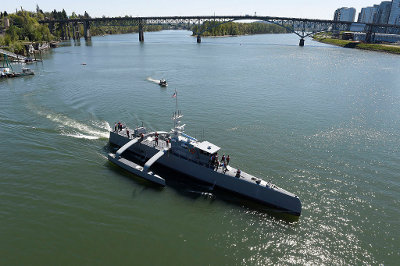
During the trials, the 132ft-long trimaran vessel met all performance objectives for speed, manoeuvrability, stability, seakeeping, acceleration / deceleration, and fuel consumption of the vessel.
The test also intended to evaluate the vessel’s mechanical system reliability while at sea.
Leidos is planning to conduct further tests in the coming months to validate the vessel’s sensors, autonomy suite, and compliance with maritime collision regulations as well as proof-of-concept demonstrations for a range of US Navy missions.
Full story here:
Leidos completes initial performance trials of US Navy’s first ACTUV Sea Hunter - Naval Technology
Just saw this update on the sea trials of the US Navy's long, thin drone ship:
Leidos completes initial performance trials of US Navy’s first ACTUV Sea Hunter
The technology demonstration system trials were conducted off the coast of San Diego, California, US.

During the trials, the 132ft-long trimaran vessel met all performance objectives for speed, manoeuvrability, stability, seakeeping, acceleration / deceleration, and fuel consumption of the vessel.
The test also intended to evaluate the vessel’s mechanical system reliability while at sea.
Leidos is planning to conduct further tests in the coming months to validate the vessel’s sensors, autonomy suite, and compliance with maritime collision regulations as well as proof-of-concept demonstrations for a range of US Navy missions.
Full story here:
Leidos completes initial performance trials of US Navy’s first ACTUV Sea Hunter - Naval Technology
Rustybarge
Guru
Just saw this update on the sea trials of the US Navy's long, thin drone ship:
Leidos completes initial performance trials of US Navy’s first ACTUV Sea Hunter
The technology demonstration system trials were conducted off the coast of San Diego, California, US.

During the trials, the 132ft-long trimaran vessel met all performance objectives for speed, manoeuvrability, stability, seakeeping, acceleration / deceleration, and fuel consumption of the vessel.
The test also intended to evaluate the vessel’s mechanical system reliability while at sea.
Leidos is planning to conduct further tests in the coming months to validate the vessel’s sensors, autonomy suite, and compliance with maritime collision regulations as well as proof-of-concept demonstrations for a range of US Navy missions.
Full story here:
Leidos completes initial performance trials of US Navy’s first ACTUV Sea Hunter - Naval Technology
The Actuv is strikingly similar to the Kurt Hughes motor tri design, which bodes well for its pracitality as a workable seaworthy boat; I think that's a given with Kurt's extraordinary high profile reputation in multihull design.
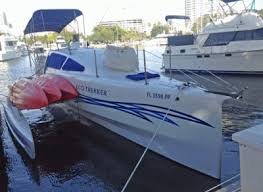
you only need about 20hp/ ton in a multihull to achieve 15kts cruise , a steel low cost tri would make perfect sense as its only going to need a few extra HP to compensate for the extra weight.
Here in Europe you can get a steel hull fabricated in any yard for about €1k/ft, less than half the cost of alloy; even less if you can build yourself with steel at €300 /ton!
38' x 8' tri hull to fit standard 12mtr mooring : €40k
Cummins 6bt 210 HP remanufactured: €20k
Windows : €5k
Wiring , tanks: €5k
Cross beams /AMA's: €5k
...say €80k ready for fitout....
Last edited:
LRC58Fan;453892[url=http://dominocatamaran.blogspot.com/2016/06/broadsword-ultimate-passagemaker.html said:DOMINO 20: BROADSWORD - The Ultimate Passagemaker[/url]
Took a quick look at your LRC58, but I see a few issues with it as an open ocean cruiser:
- No dedicated pilothouse. Having completely darkened steering at night is vital.
- Lack of a transom door with that huge opening will lets tons (literally) of water onboard during rough water.
- Displacement of 14 tons is about equivalent to a 35ft heavy trawler. Since that's spread out to almost 60ft that vessel is going to have very high accelerations in all directions.
Would be interesting to see how it handles on its trans-pacific voyage.
Rustybarge
Guru
Just saw this update on the sea trials of the US Navy's long, thin drone ship:
Leidos completes initial performance trials of US Navy’s first ACTUV Sea Hunter
The technology demonstration system trials were conducted off the coast of San Diego, California, US.

During the trials, the 132ft-long trimaran vessel met all performance objectives for speed, manoeuvrability, stability, seakeeping, acceleration / deceleration, and fuel consumption of the vessel.
The test also intended to evaluate the vessel’s mechanical system reliability while at sea.
Leidos is planning to conduct further tests in the coming months to validate the vessel’s sensors, autonomy suite, and compliance with maritime collision regulations as well as proof-of-concept demonstrations for a range of US Navy missions.
Full story here:
Leidos completes initial performance trials of US Navy’s first ACTUV Sea Hunter - Naval Technology
The Actuv is strikingly similar to the Kurt Hughes motor tri design, which bodes well for its pracitality as a workable seaworthy boat; I think that's a given with Kurt's extraordinary high profile reputation in multihull design.

you only need about 20hp/ ton in a multihull to achieve 15kts cruise , a steel low cost tri would make perfect sense as its only going to need a few extra HP to compensate for the extra weight.
Here in Europe you can get a steel hull fabricated in any yard for about €1k/ft, less than half the cost of alloy; even less if you can build yourself with steel at €300 /ton!
38' x 8' tri hull to fit standard 12mtr mooring : €40k
Cummins 6bt 210 HP remanufactured: €20k
Windows : €5k
Wiring , tanks: €5k
Cross beams /AMA's: €5k
...say €80k ready for fitout....
Here's a link on the cost of a suitable narrow beam steel hull , but obviously would need modification to make it into a trimaran using thinner plate and different underwater sections.
10, 11 and 12 ft Wide Canal Boat Prices
The lack of a pilothouse seems to work in a lot of these long thin designs - I think they have "red" LED lighting that they use in the "great room" when they are passagemaking at night.
I like this design approach because it keeps people together and doesn't break up what is already a relatively small space into even smaller spaces. You can see it also in the Dashew designs as shown below - and his boats are well proven passagemakers - more so than most pilot house designs I think. I like the clean modern and open design. Obviously this is from a set of large boats (the Dashew 97 ft and 70 foot boats) so more space than in the LRC 58 - but the concept is the same.
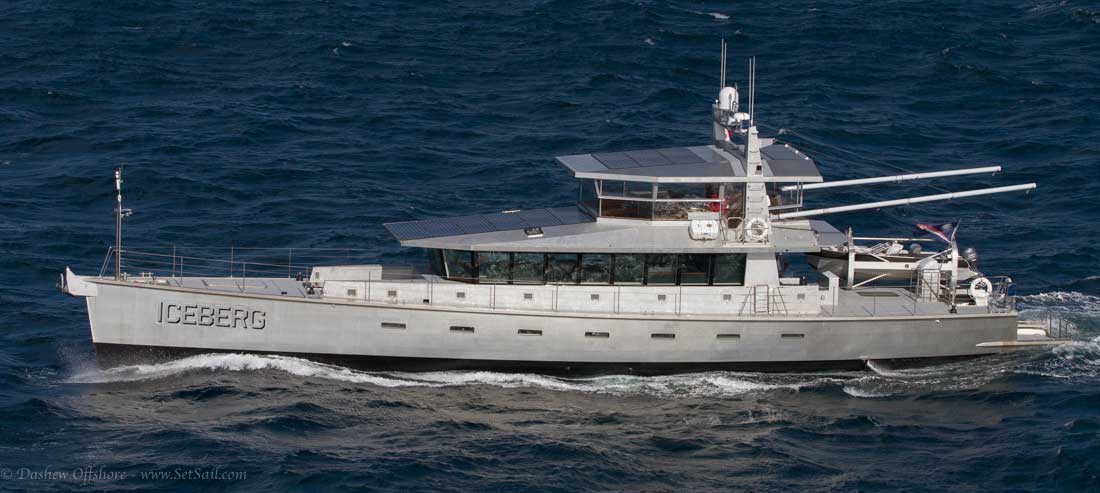
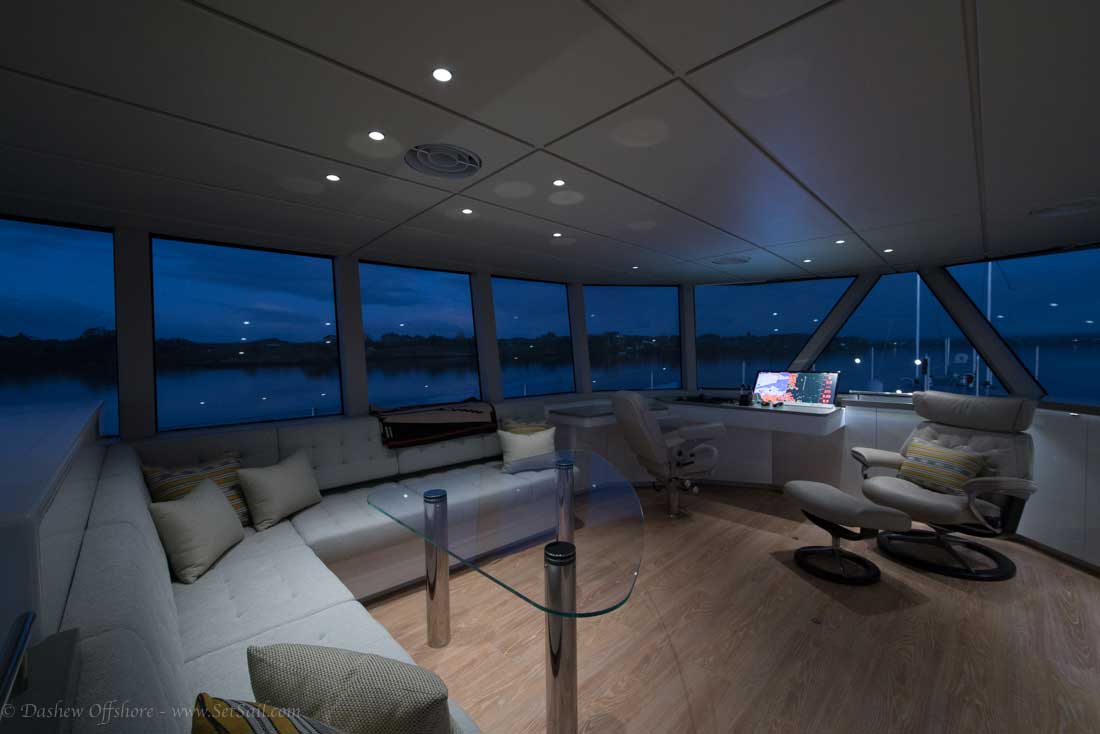
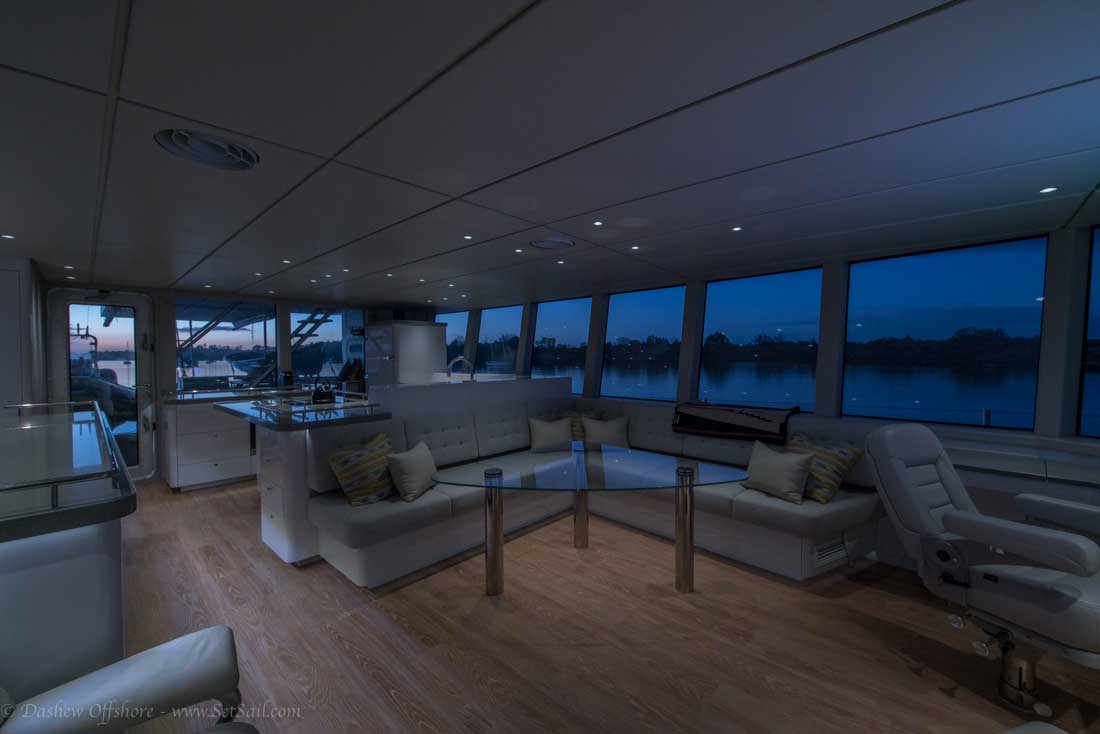
(from the setsail.com web site here:
http://www.setsail.com/category/wicked-fpb/
and
http://www.setsail.com/fpb-78-1-cochise-interior-first-look/
The Artnautica LRC 58 has some sort of pull up rear transom door - as can be seen here:
https://www.facebook.com/300243140002724/photos/pcb.1216131728413856/1216131321747230/?type=3&theater
The issue of "high acceleration" (which I take it to mean roll period) is, it seems, a big of an issue right now - but the designer seems to be addressing it as you can read about on his Facebook page:
https://www.facebook.com/Artnautica-Yacht-Design-Ltd-300243140002724/
"Lengthening the roll period would be a nice option to have. I have been thinking of a tank like you mentioned, also adding weight to the ends of the booms might work well since when they are all the way out they are five metres off centreline. I will get a pair of flopped stoppers soon to stabilise eth boat when anchored. Wakes of passing boats can make for a bit of discomfort from time to time."
The "Hard Chine" design would seem to contribute to this issue.
I agree about the the need for much more data on the success and comfort and safety of the transpacific performance of the design. I am watching to see as more data is released.
I like this design approach because it keeps people together and doesn't break up what is already a relatively small space into even smaller spaces. You can see it also in the Dashew designs as shown below - and his boats are well proven passagemakers - more so than most pilot house designs I think. I like the clean modern and open design. Obviously this is from a set of large boats (the Dashew 97 ft and 70 foot boats) so more space than in the LRC 58 - but the concept is the same.



(from the setsail.com web site here:
http://www.setsail.com/category/wicked-fpb/
and
http://www.setsail.com/fpb-78-1-cochise-interior-first-look/
The Artnautica LRC 58 has some sort of pull up rear transom door - as can be seen here:
https://www.facebook.com/300243140002724/photos/pcb.1216131728413856/1216131321747230/?type=3&theater
The issue of "high acceleration" (which I take it to mean roll period) is, it seems, a big of an issue right now - but the designer seems to be addressing it as you can read about on his Facebook page:
https://www.facebook.com/Artnautica-Yacht-Design-Ltd-300243140002724/
"Lengthening the roll period would be a nice option to have. I have been thinking of a tank like you mentioned, also adding weight to the ends of the booms might work well since when they are all the way out they are five metres off centreline. I will get a pair of flopped stoppers soon to stabilise eth boat when anchored. Wakes of passing boats can make for a bit of discomfort from time to time."
The "Hard Chine" design would seem to contribute to this issue.
I agree about the the need for much more data on the success and comfort and safety of the transpacific performance of the design. I am watching to see as more data is released.
Took a quick look at your LRC58, but I see a few issues with it as an open ocean cruiser:
- No dedicated pilothouse. Having completely darkened steering at night is vital.
- Lack of a transom door with that huge opening will lets tons (literally) of water onboard during rough water.
- Displacement of 14 tons is about equivalent to a 35ft heavy trawler. Since that's spread out to almost 60ft that vessel is going to have very high accelerations in all directions.
Would be interesting to see how it handles on its trans-pacific voyage.
Last edited:
Posted by makobuilders
I received a quote to build a 70' long skinny boat for about the same cost as a 50' wide fat one. Same displacement. I am not going to be a full time live aboard, so when I start budgeting for marina fees in various ports the numbers are a true deal-killer!
MurrayM: Even after factoring in the smaller engine(s) and reduced fuel costs?
I happened to come across this old thread. As I've restarted negotiations with the other shipyard for a "long, skinny" boat, we are now considering powering. The powering of the high L/B boat is lower for the same speed as the low L/B vessel. Taking into consideration the difference in power required to overcome headwinds/seas/etc., it's at a point where we can drop to a 4 cylinder engine versus 6 cylinder for the fat boy.
An extra $5k saved here and there does add up, as is the big difference in fuel economy. So I'm giving it serious consideration.
FF
Guru
- Joined
- Oct 12, 2007
- Messages
- 22,552
An extra $5k saved here and there does add up, as is the big difference in fuel economy. So I'm giving it serious consideration
At displacement speeds wetted area , skin friction is about equal to wave making resistance.
Long and thin has higher wetted areas so is less efficient at low displacement speeds.
In terms of economy a beach ball underwater would be winner .
At displacement speeds wetted area , skin friction is about equal to wave making resistance.
Long and thin has higher wetted areas so is less efficient at low displacement speeds.
In terms of economy a beach ball underwater would be winner .
Xlantic
Guru
I anchored next to these two "trawlers" earlier this summer in Panarea, in the Aeolian Islands off the northe-east coats of Sicily. Sort of like the beauty and beast!
The skinny trimaran is Adastra and has been commented on earlier in this thread. The converted tug is named Vervece.
I looked them up and they both have 1000 hp motors but Vervece has two of them and cruises at 12 knots while Adastra has one and cruises at 17 knots. While the lengths are not terribly dissimilar (42.5 metres for Adastra and 30 metres for Vervece) the big difference is tonnage: 68t for Adastra and 250t for Vervece.
The skinny trimaran is Adastra and has been commented on earlier in this thread. The converted tug is named Vervece.
I looked them up and they both have 1000 hp motors but Vervece has two of them and cruises at 12 knots while Adastra has one and cruises at 17 knots. While the lengths are not terribly dissimilar (42.5 metres for Adastra and 30 metres for Vervece) the big difference is tonnage: 68t for Adastra and 250t for Vervece.
Attachments
Nomad Willy
Guru
I see two beasts.
Similar threads
- Replies
- 7
- Views
- 769
- Replies
- 47
- Views
- 4K
- Replies
- 0
- Views
- 2K

